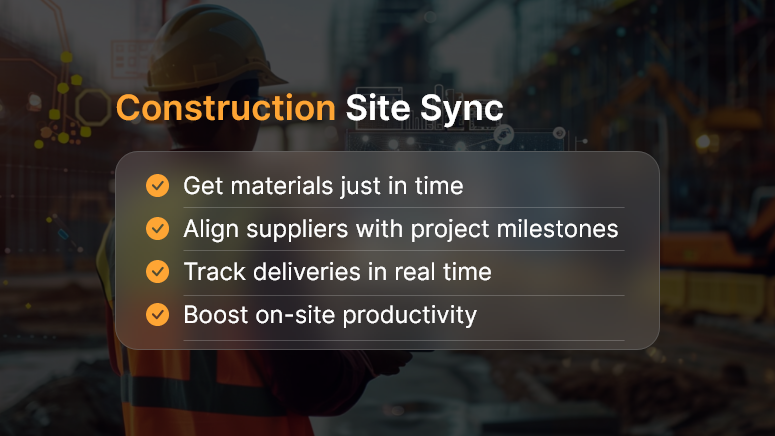In every construction or infrastructure project, timing is everything. A single material delay can halt work, inflate costs, and disrupt downstream schedules. That’s where logistics optimization comes in — a data-driven process that ensures materials arrive exactly when needed, neither too early (clogging storage space) nor too late (stalling progress).
For modern construction teams, logistics optimization isn’t just about moving goods — it’s about coordinating procurement, transport, warehousing, and delivery schedules in perfect sync with the project plan.

What Is Logistics Optimization?
Logistics optimization is the strategic process of planning, executing, and refining material delivery schedules to align perfectly with project milestones. It uses real-time data from procurement, suppliers, and project sites to predict demand, plan transport routes, and coordinate warehouse releases efficiently.
Key Components
- Demand Forecasting: Predicting what materials are needed and when.
- Route Planning: Determining the fastest, most cost-effective routes for delivery.
- Warehouse Scheduling: Managing dispatch and storage to prevent overstocking.
- Supplier Coordination: Synchronizing supplier timelines with project deadlines.
Why Construction Projects Need Logistics Optimization
Unlike manufacturing or retail, construction logistics face unique challenges — variable site conditions, weather risks, and fluctuating resource availability. Optimized logistics allow you to:
- Avoid Material Shortages: Ensure every material is available before work begins.
- Reduce Idle Time: Keep equipment and labor productive without delays.
- Save Storage Costs: Deliver materials just in time to avoid warehousing overhead.
- Enhance Accountability: Track material movement across suppliers and contractors.
- Improve Sustainability: Optimize delivery frequency and reduce fuel consumption.
The Role of Technology in Logistics Optimization
Today, digital platforms like OConstruction or Orangescrum play a crucial role in synchronizing field operations with supply chain workflows.
1. Real-Time Tracking
GPS-enabled tracking provides instant visibility of trucks, materials, and delivery status.
2. Automated Alerts
Teams receive notifications if deliveries are delayed, rerouted, or rescheduled.
3. Integrated Scheduling
The project Gantt chart directly links with supplier schedules, ensuring every delivery aligns with on-site activity.
4. Predictive Insights
AI-based forecasting tools predict material demand, helping planners avoid both shortages and surplus.
5. Collaboration Dashboards
Stakeholders — contractors, vendors, and logistics partners — collaborate in one workspace, reducing miscommunication.
How to Implement Logistics Optimization
Step 1: Map Your Supply Chain
Document all suppliers, warehouses, and delivery points. Identify bottlenecks or dependencies that frequently cause delays.
Step 2: Digitize Material Planning
Use project management software to create a material requirement plan (MRP) linked to project tasks and milestones.
Step 3: Set Up Smart Scheduling
Adopt just-in-time delivery models, ensuring materials arrive only when the site is ready to use them.
Step 4: Integrate Data Systems
Connect procurement, inventory, and transportation systems under one digital platform.
Step 5: Monitor and Improve
Use analytics dashboards to track performance metrics like delivery lead times, transport utilization, and delay frequency.
Benefits of Optimized Logistics
| Benefit | Impact |
| Reduced Delays | Seamless coordination between suppliers and project timelines. |
| Lower Costs | Less idle labor, lower fuel and storage expenses. |
| Improved Quality | Materials handled and stored properly before use. |
| Enhanced Safety | Minimized on-site clutter and equipment congestion. |
| Greater Transparency | Real-time visibility into supply chain activities. |
Common Challenges in Logistics Optimization
Despite its advantages, several issues can still arise:
- Unpredictable Delays: Weather, strikes, or vehicle breakdowns.
- Supplier Non-Compliance: Vendors failing to follow just-in-time schedules.
- Lack of Integration: Disconnected systems across procurement, transport, and projects.
- Manual Tracking: Human error in data entry or delivery documentation.
The solution lies in automation and integration — ensuring all stakeholders work on a single, real-time data platform.
Best Practices for Construction Logistics Optimization
- Adopt Just-In-Time (JIT) Procurement: Align deliveries with activity schedules.
- Use Predictive Analytics: Anticipate material needs and delivery delays.
- Establish Clear SLAs with Suppliers: Define delivery times, penalties, and escalation paths.
- Centralize Communication: Keep everyone informed using digital collaboration tools.
- Review and Adjust Weekly: Logistics is dynamic; continuous improvement keeps it efficient.
How OConstruction Simplifies Logistics Planning
Platforms like OConstruction and Orangescrum are designed to remove the guesswork from material logistics.
- Integrated Material Scheduling: Link every delivery with project milestones.
- Vendor Coordination: Invite suppliers to track and confirm deliveries directly.
- Analytics & Dashboards: Get insights into delivery performance and cost efficiency.
- Real-Time Alerts: Receive instant notifications for delays or dispatch issues.
With these tools, you can achieve end-to-end logistics visibility, ensuring your projects run on schedule and under budget.
Conclusion
Logistics optimization isn’t just a backend process — it’s a strategic advantage. By aligning material flow with project timelines, companies can eliminate waste, reduce delays, and increase profitability.
In a fast-moving world of tight margins and complex projects, mastering logistics optimization is the key to operational excellence.
FAQs on Logistics Optimization
1. What does logistics optimization mean in construction?
It means planning and managing material deliveries so they arrive exactly when needed, avoiding delays and excess storage.
2. How does logistics optimization improve project efficiency?
It ensures that labor, equipment, and materials are available in sync, reducing idle time and costs.
3. What tools help with logistics optimization?
Tools like OConstruction and Orangescrum provide scheduling, tracking, and analytics dashboards.
4. How does real-time tracking support logistics?
It gives visibility of delivery status, location, and estimated arrival times.
5. What is Just-In-Time (JIT) delivery?
It’s a logistics strategy that ensures materials arrive right before they are needed for use.
6. Can logistics optimization reduce costs?
Yes — by minimizing storage, fuel, and downtime costs.
7. How does AI improve logistics planning?
AI predicts material demand and identifies potential delivery risks before they occur.
8. What are common causes of delivery delays?
Supplier issues, route inefficiencies, poor weather, and manual tracking errors.
9. How often should logistics data be reviewed?
Ideally, weekly, to adapt to changing site conditions and project timelines.
10. What’s the biggest advantage of digital logistics systems?
End-to-end visibility and collaboration between all project stakeholders.



